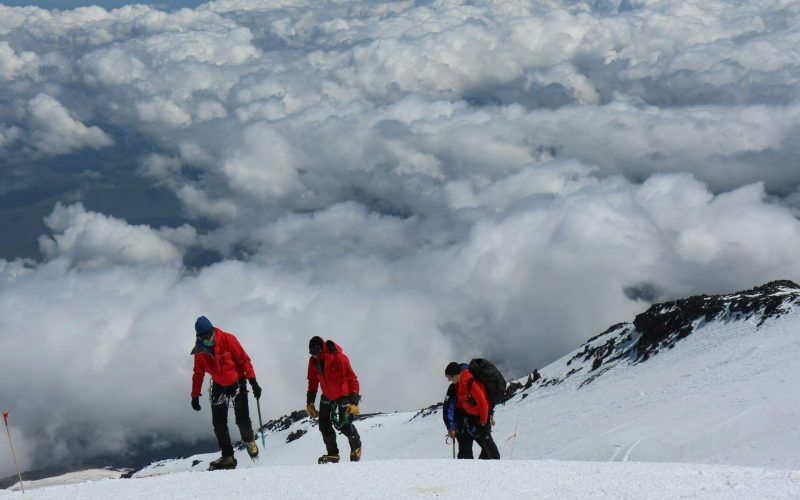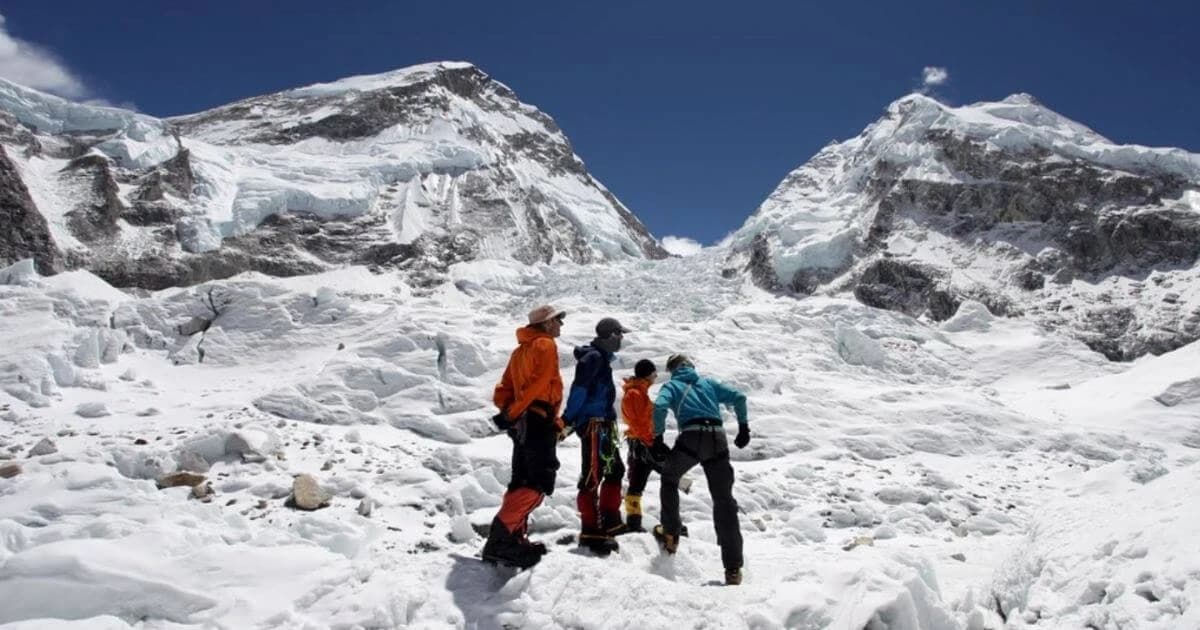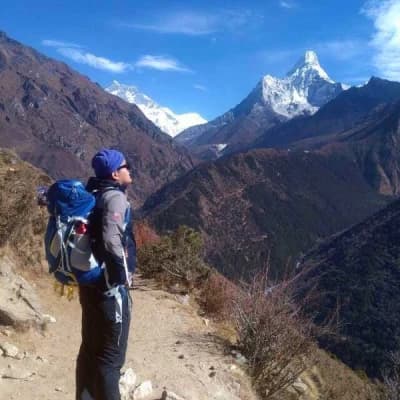Mount Everest, the world’s tallest mountain, is the dream of every adventurous soul. But before embarking on this challenging yet beautiful journey to Mount Everest, one crucial question arises: “How long does it take to climb Mount Everest?” OR “How long does it take to climb down Mount Everest?”
Everest isn’t just a single push to the top; it’s a multi-stage process. The primary step is to reach Everest Base Camp Trek (5364 meters). Climbing Everest takes approximately six to nine weeks, and stepping down takes 4 to 8 hours.
The journey tests human endurance and spirit, whether reaching the summit or trekking to Everest Base Camp. If you are wondering how long it takes to climb Mount Everest from base camp, It takes an average of 40 days to climb to the peak of Mt. once you’ve reached the Base Camp.
Factor Affecting Climbing Time
Climbing Mount Everest is a challenging task. Though the first climb was done in the 1950s, without the proper gear and knowledge of how long it takes to reach the summit, Norgay and Hillary conquered Mount Everest and became the legends of the Himalayas. The fastest time to climb Mount Everest was just 8 hours and 10 minutes by Nepali climber Pemba Dorje Sherpa in 2004.
The dedication and duration required to complete the climb can vary depending on various factors. Here are some of the most significant factors:
1. Weather Condition and Season
Temperatures at such heights are highly challenging, and the weather is unpredictable. High winds, blizzards, and extreme cold at the peak of Mount Everest can slow down or influence people to turn back. The best time to climb Mount Everest is in the spring (May) and fall (September), when the weather is generally more stable.
2. Altitude and Acclimation Process
Mount Everest is 8848 m high, and ascending such a height is highly challenging for climbers. This can cause altitude sickness, leading to various health issues like headaches, nausea, fatigue, and shortness of breath. It could be life-threatening, and it takes climbers days to acclimate to the high altitude.
3. Physical and Mental Fitness
The physical and mental fitness of the climbers plays a significant role in climbing. Climbers with strength and endurance can climb steep slopes in the thin air. Climbers need strong determination, resilience, and focus to handle the challenges and potential setbacks throughout the climb.
4. Duration for Climbing Mt Everest
The estimated climbing duration for Mount Everest is around two months (60 days). However, this is just an average, and the actual time can vary significantly depending on weather, altitude, and physical fitness.
The following factors can also significantly affect the duration of climbing Mount Everest.
- Climber Experience: Experienced climbers tend to be faster due to better acclimatization and efficiency than inexperienced climbers.
- Team Size and Dynamics: Larger teams move slower and may encounter delays due to waiting for everyone, ultimately slowing the process.
- Route Choice: Different routes offer varying difficulty and require different climbing techniques, impacting the overall time.
- Support: Experienced guides can expedite the process by assisting with navigation, camp setup, and emergencies.
What is the Fastest Time to Climb Everest?
The fastest recorded ascent of Mount Everest with supplemental oxygen was 8 hours and 10 minutes by Pemba Dorje, a Sherpa climber, on May 21, 2004. However, the fastest recorded time to climb Everest without supplemental oxygen is 25 hours and 1 minute by Nirmal ‘Nims’ Purja, a Nepalese mountaineer, on May 15-16,2022.
Can you Climb Mount Everest in 24 hours?
Attempting to climb Mount Everest in 24 hours is extremely dangerous and unrealistic. The climb involves highly steep terrain and unpredictable weather conditions. Even during the climbing season, there is a risk of high winds, blizzards, and extreme cold, which can occur, forcing climbers to descend or wait.
How Long Does it Take to Climb Mount Everest from Base Camp?
Climbing from Base Camp marks the official start of the ascent. The first phase involves 15-18 days to reach the Everest Base Camp, depending upon your fitness level. This depends on the chosen route and acclimatization. The average time to climb Mount Everest is around 40 days.
What are the Expeditions and Climbing Strategies on Everest?
Climbing Mount Everest is a complex and challenging process that requires months of planning, preparation, and a well-defined strategy. Some specific structures, routes, and considerations before conquering Mount Everest are:
Pre-Expedition
This training helps the climber build strength through physical and mental training. It also involves acquiring climbing skills and practicing using specialized equipment. While not mandatory, most climbers use supplemental oxygen due to the shallow oxygen level at such a high altitude.
South Col Route (Nepal)
This is the most popular and commercially guided route, considered the “standard” route for climbing Everest. It ascends the Khumbu Icefall, traverses the Western Cwm, and reaches the summit via the South Col and Hillary Step.
Safety
Managing risk is paramount. Climbers must know the dangers of high altitude, such as altitude sickness, avalanches, and falling ice. Careful planning, preparation, and sound decision-making are crucial for a safe climb.
How Much Does Climb Mount Everest Cost?
A beginner may not know How Much Does it Cost to Climb Mount Everest. The estimated cost of climbing Mount Everest falls within the range of $32000 to USD 200,000. This includes professional guides, support staff, food, tents, and permits. Personal gear can range from $6,000 to $8,000, depending on the quality and specific items you need. Visas, pre- and post-expedition accommodation, and other travel expenses also significantly increase the cost.
Expeditions with luxurious amenities like Western-style food, satellite internet access, and heated tents will naturally be more expensive than those with basic facilities.
Travel Permits for Climbing Mount Everest
Permits are the entry cards. It grants you permission to enter a specific region, trek to base camp, and attempt to climb a summit.
- Sagarmatha National Park Permit: Allows entry into Sagarmatha National Park, which encompasses Nepal's Everest Base Camp region.
- Khumbu Pasang Lhamu Rural Municipality Permit: Grants permission to enter the Khumbu Pasang Lhamu Rural Municipality, which includes Everest Base Camp and the surrounding villages.
- TIMS (Trekkers’ Information Management System) Card: Mandatory for all trekkers in Nepal, including those going to Everest Base Camp.
What are the Necessary Equipment and Gear for Climbing Everest?
Climbing Mount Everest requires proper planning and knowledge of equipment and gear. Besides clothing, footwear, and first-aid kits, the following equipment must be considered.
- Ice Axe: A general mountaineering ice axe is essential for self-arresting, traversing crevasses, and providing stability on icy terrain.
- Crampons: General mountaineering crampons with sharp points are necessary for gripping ice and snow securely.
- Carabiner System: A selection of locking and non-locking carabiners in various sizes is needed for connecting ropes, attaching gear, and building anchors.
- Harness: A comfortable and adjustable climbing harness with gear loops allows safe attachment to ropes and belay systems.
- Ropes (Optional): While fixed ropes are present on standard routes, some climbers carry personal climbing ropes for specific situations.
- Belay Device: This specialized equipment aids in controlling the rope during belaying and rappelling.
- Ascenders: These mechanical devices assist climbers in ascending fixed ropes when necessary.
What are the Challenges and Risks of Climbing Mount Everest?
Mount Everest lies in the “death zone,” where the atmosphere is thin, and oxygen levels are about one-third of what they are at sea level. This can lead to altitude sickness.
High winds, blizzards, and sudden whiteouts can increase the risk of hypothermia and frostbite. Climbers must be prepared for rapidly changing weather patterns and have the skills to navigate these challenges.
A well-organized and experienced team with proper logistical support is crucial for a successful and safe climb. This includes having experienced guides, Sherpas, and access to necessary medical supplies and equipment.
Guide for Planning and Preparation for Climbing Mount Everest
Climbing Mount Everest requires months of planning and strong dedication to conquer Everest. So, following are some guides for planning and preparation for climbing Mount Everest.
Physical Fitness:
Climbing Mount Everest demands peak physical condition. Cardiovascular endurance, strength training, and altitude acclimatization is essential.
Technical Skills:
If you lack experience in glacier travel, rope work, and self-arrest techniques, seek professional instruction and practice these skills in controlled environments before attempting Everest.
First-Aid Training:
Equipping yourself with basic first-aid knowledge and wilderness survival skills can be invaluable in emergencies on the mountain.
Insurance:
Purchase comprehensive travel insurance covering high-altitude mountaineering activities, including medical evacuation and emergency repatriation.
Double-Check and Maintain Gear:
Before the expedition, ensure all your equipment is in good working order. Pack spare parts and repair kits for potentially damaged gear.
Understand the Route:
Decide on your chosen route, whether the South Col Route (Nepal) or the North Col Route (Tibet). Each route presents different challenges and logistical considerations.
Recommended Read: Trekking Preparation for Nepal
Final Thoughts
Climbing Mount Everest is an incredible challenge that demands courage, preparation, and respect for nature. Every aspect requires careful consideration, from understanding the timeframes to facing the risks. While the allure of Everest is undeniable, safety and sustainability should always be priorities.
Ultimately, conquering the mountain is not just about discovering our strengths and limitations. However, if you’re a Mount Everest enthusiast but feel you’re not quite ready to climb the top of the world, embark on an exhilarating journey with Tidy Himalaya for a diverse range of Everest Region trekking packages suited for every level.
FAQs:
In what country is Mount Everest located?
Mount Everest is not located in a single country. It straddles the border between Nepal and the Tibet Autonomous Region of China. The South Col Route, the most popular climbing route, starts in Nepal, while the North Col Route is accessed from Tibet.
Recommended Read: Where is Mount Everest Located
How many people climb Mount Everest a year?
Approximately 800 people attempt to climb Mount Everest annually. This number includes successful summit attempts and those unable to reach the peak due to various factors, such as weather conditions, altitude sickness, or other challenges.
Do people still climb Everest without oxygen?
Yes, people still climb Mount Everest without using supplemental oxygen, although it is a very rare and dangerous feat attempted by very few. Climbing without oxygen significantly increases the risk of altitude sickness, a potentially fatal condition.
How long can a person stay on Mount Everest?
Due to the deficient oxygen levels at high altitudes on Mount Everest, particularly in the “death zone” above 8,000 meters (26,247 feet), no one should stay for 16-20 hours even with the oxygen supplements.
What is the death zone on Mount Everest?
The death zone refers to high-altitude areas with insufficient oxygen to sustain human life for extended periods. It is generally accepted that the zone begins at 8,000 meters (26,247 feet) above sea level.
Can an unfit person climb Everest?
No, an unfit person cannot climb Mount Everest because it requires peak physical condition to endure strenuous activity, challenging terrain, and harsh weather conditions. It involves long days of trekking, carrying heavy backpacks, climbing steep slopes, and battling thin air in the death zone.


.webp&w=1200&q=75&dpl=dpl_2PwU5ZDv8uoJ3KrzEVbz8N547HgX)
.webp&w=1200&q=75&dpl=dpl_2PwU5ZDv8uoJ3KrzEVbz8N547HgX)
.webp&w=1200&q=75&dpl=dpl_2PwU5ZDv8uoJ3KrzEVbz8N547HgX)